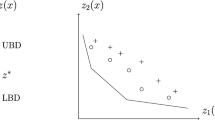Abstract
The literature knows semi-Lagrangian relaxation as a particular way of applying Lagrangian relaxation to certain linear mixed integer programs such that no duality gap results. The resulting Lagrangian subproblem usually can substantially be reduced in size. The method may thus be more efficient in finding an optimal solution to a mixed integer program than a “solver” applied to the initial MIP formulation, provided that “small” optimal multiplier values can be found in a few iterations. Recently, a simplification of the semi-Lagrangian relaxation scheme has been suggested in the literature. This “simplified” approach is actually to apply ordinary Lagrangian relaxation to a reformulated problem and still does not show a duality gap, but the Lagrangian dual reduces to a one-dimensional optimization problem. The expense of this simplification is, however, that the Lagrangian subproblem usually can not be reduced to the same extent as in the case of ordinary semi-Lagrangian relaxation. Hence, an effective method for optimizing the Lagrangian dual function is of utmost importance for obtaining a computational advantage from the simplified Lagrangian dual function. In this paper, we suggest a new dual ascent method for optimizing both the semi-Lagrangian dual function as well as its simplified form for the case of a generic discrete facility location problem and apply the method to the uncapacitated facility location problem. Our computational results show that the method generally only requires a very few iterations for computing optimal multipliers. Moreover, we give an interesting economic interpretation of the semi-Lagrangian multiplier(s).
Similar content being viewed by others
References
Ahn S, Cooper C, Cornuejols G, Frieze AM (1988) Probabilistic analysis of a relaxation for the \(k\)-median problem. Math Oper Res 13:1–31
Avella P, Boccia M (2009) A cutting plane algorithm for the capacitated facility location problem. Comput Optim Appl 43:39–65
Avella P, Sassano A, Vasilev I (2007) Computational study of large-scale \(p\)-median problems. Math Program 109:89–114
Avella P, Boccia M, Sforza A, Vasil’ev I (2009) An effective heuristic for large-scale capacitated facility location problems. J Heuristics 15:597–615
Babonneau F, Beltran C, Haurie A, Tadonki C, Vial JP (2004) Proximal-ACCPM: a versatile oracle based optimization method. Optimization (online). http://www.optimization-online.org/DB_HTML/2004/10/986.html
Barahona F, Anbil R (2000) The volume algorithm: producing primal solutions with a subgradient method. Math Program 87:385–399
Barahona F, Chudak F (2005) Near-optimal solutions to large-scale facility location problems. Discrete Optim 2:35–50
Belik I, Jörnsten K (2014) A new semi-Lagrangean relaxation for the \(k\)-cardinality assignment problem. Discussion Paper FOR 1 2014, Department of Business and Management Science, Norwegian School of Economics, Bergen, Norway. http://ssrn.com/abstract=2380024
Beltran C, Tadonki C, Vial JP (2006) Solving the \(p\)-median problem with a semi-Lagrangian relaxation. Comput Optim Appl 35:239–260
Beltran-Royo C, Vial JP, Alonso-Ayuso A (2012) Semi-Lagrangian relaxation applied to the uncapacitated facility location problem. Comput Optim Appl 51:387–409
Bilde O, Krarup J (1977) Sharp lower bounds and efficient algorithms for the simple plant location problem. Ann Discrete Math 1:79–97
Christofides N, Beasley JE (1982) A tree search algorithm for the \(p\)-median problem. Eur J Oper Res 10:196–204
Cornuejols G, Fisher ML, Nemhauser GL (1977) Location of bank accounts to optimize float: an analytic study of exact and approximate algorithms. Manag Sci 23:789–810
Cornuejols G, Nemhauser GL, Wolsey LA (1980) A canonical representation of simple plant location problems and its applications. SIAM J Algebra Discret Methods 1:261–272
Cornuejols G, Fisher ML, Nemhauser GL (1990) The uncapacitated facility location problem. In: Mirchandani PB, Francis RL (eds) Discrete location theory. Wiley, New York, pp 119–171
Dos Santos Eleuterio VL (2009) Finding approximate solutions to large linear programs. Dissertation ETH No 18188, ETH Zürich
Elloumi S (2008) A tighter formulation for the \(p\)-median problem. J Comb Optim 19:69–83
Erlenkotter D (1978) A dual-based procedure for uncapacitated facility location. Oper Res 26:992–1009
Ghosh D (2003) Neighborhood search heuristics for the uncapacitated facility location problem. Eur J Oper Res 150:150–162
Goffin JL, Vial JP (2002) Convex nondifferentiable optimization: a survey focussed on the analytic center cutting plane method. Optim Method Softw 17:805–867
Goffin JL, Haurie A, Vial JP (1992) Decomposition and nondifferentiable optimization with the projective algorithm. Manag Sci 38:284–302
Guastaroba G, Speranza MG (2009) Kernel search for the capacitated facility location problem. J Heuristics 18:877–917
Hanjoul P, Peeters D (1985) A comparison of two dual-based procedures for solving the \(p\)-median problem. Eur J Oper Res 20:387–396
Hansen P, Brimberg J, Mladenović DUN (2007) Primal-dual variable neighborhood search for the simple plant-location problem. INFORMS J Comput 19:552–564
Janacek J, Buzna L (2008) An acceleration of Erlenkotter–Koerkel’s algorithms for the uncapacitated facility location problem. Ann Oper Res 164:97–109
Khumawala BM (1972) An efficient branch and bound algorithm for the warehouse location problem. Manag Sci 18:B718–B731
Klose A (1998) A branch and bound algorithm for an uncapacitated facility location problem with a side constraint. Int Trans Oper Res 5:155–168
Körkel M (1989) On the exact solution of large-scale simple plant location problems. Eur J Oper Res 39:157–173
Krarup J, Pruzan PM (1983) The simple plant location problem: survey and synthesis. Eur J Oper Res 12:36–81
Kratica J, Tosic D, Filipovic V, Ljubic I (2001) Solving the simple plant location problem by genetic algorithm. RAIRO-Oper Res 35:127–142
Letchford AN, Miller SJ (2012) Fast bounding procedures for large instances of the simple plant location problem. Comput Oper Res 39:985–990
Letchford AN, Miller SJ (2014) An aggressive reduction scheme for the simple plant location problem. Eur J Oper Res 234:674–682
Mansini R, Speranza MG (2012) Coral: an exact algorithm for the multidimensional Knapsack problem. INFORMS J Comput 24:399–415
Monabbati E (2014) An application of a Lagrangian-type relaxation for the uncapacitated facility location problem. Jpn J Ind Appl Math 31:483–499
Nemhauser GL, Wolsey LA (1981) Maximizing submodular set functions: formulations and analysis of algorithms. Ann Discrete Math 11:279–301
Nesterov Y (2009) Primal-dual subgradient methods for convex problems. Math Program 120:221–259
Pisinger D (1997) A minimal algorithm for the 0–1 Knapsack problem. Oper Res 45:758–767
Posta M, Ferland JA, Michelon P (2014) An exact cooperative method for the uncapacitated facility location problem. Math Program Comput 6:199–231
Resende MG, Werneck RF (2006) A hybrid multistart heuristic for the uncapacitated facility location problem. Eur J Oper Res 174:54–68
Verter V (2011) Uncapacitated and capacitated facility location problem. In: Eiselt HA, Marionov V (eds) Foundations of locational analysis. Springer, Berlin, pp 25–37
Author information
Authors and Affiliations
Corresponding author
Rights and permissions
About this article
Cite this article
Jörnsten, K., Klose, A. An improved Lagrangian relaxation and dual ascent approach to facility location problems. Comput Manag Sci 13, 317–348 (2016). https://doi.org/10.1007/s10287-015-0244-z
Received:
Accepted:
Published:
Issue Date:
DOI: https://doi.org/10.1007/s10287-015-0244-z




